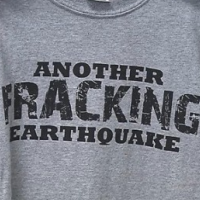More than Half of Fracked Wells Are Within 10 Miles of an Active Earthquake Fault

Hydraulic fracturing (fracking), acidizing and other controversial oil and gas extraction techniques linked to man-made earthquakes are used in close proximity to earthquake faults in California, according to a study (pdf) by the Center for Biological Diversity.
The Center for Biological Diversity's “On Shaky Ground: Fracking, Acidizing and Increased Earthquake Risk in California” says that of the state's 1,553 active wastewater injection wells used in the processes 6% are within one mile of a known fault, 23% are within five miles and 54% are within 10 miles.
Much of the drilling in high-risk zones is located near heavily-populated areas.
Much of the drilling in high-risk zones is located near heavily-populated areas. The 4.4-earthquake that shook Los Angeles Monday morning has not been linked to injection wells, but its epicenter was eight miles from one.
Fracking and other extraction techniques inject pressurized water, toxic chemicals and other materials into the ground to crack open new drilling space and then recycle the wastewater into other wells. About 20% of fracking materials injected into the ground come back up as wastewater.
Much of the focus on the oil and gas industry's push to ramp up fracking et al has been on the threat it poses to groundwater. But scientists have begun to document its effect on ground stability. The report cites a number of such instances.
In October 2013, the Oklahoma Geological Survey (OGS) warned residents outside Oklahoma City that injection wells may be a “contributing factor” to a the swarms of earthquakes plaguing the area, prompting the state insurance commissioner to encourage people to buy quake insurance. Oklahoma averaged 1-3 earthquakes a year between 1975 and 2008. That jumped to 40 per year since 2009.
A 4.8 magnitude quake in Texas was attributed to wastewater injection, as well as 5.3 in Colorado, a 4.7 in Arkansas and a 3.9 in Ohio.
Earthquake activity picked up markedly in the Raton Basic of Southern Colorado and northern New Mexico after injections began in 2001. “The number of earthquakes of M3 or greater increased from 0.16 per year in the 31-year period before injection, to 9.5 per year after injection,” according to the report.
The previously earthquake-free region near Youngstown, Ohio, suffered more than 109 earthquakes between January 2011 and February 2012. Arkansas has experienced a major runup in quakes since wastewater wells began being used in 2009. After just one quake in 2007 and two in 2008, the number of incidents jumped to 10 in 2009, 54 in 2010 and 157 in 2011. The report cites a study that said the quakes were likely induced by wastewater injection.
Those states are not known for seismic activity. California is. And because of its large population, more people are at risk in this state than any other.
Maps from the FracTracker Alliance overlay drilling projects throughout the state (and other parts of the nation) on top of known seismic hazard zones. The Center for Biological Diversity used the maps to determine that 834 wells (54%) were within 10 miles of a fault that had been active during the past 200 years. The report said scientists are concerned about earthquake effects when drilling is within 12.4 miles.
Although the maps show widespread drilling in quake zones, the report singled out three at-risk counties: Ventura, Kern and Los Angeles.
Ventura County is at especially high risk of landslides and liquefaction. It also lies along the southern edge of the Monterey Shale, a repository of oil that could top 15.3 billion barrels and may represent 60% of all shale oil in the country. Fracking's recent popularity is tied to its ability to liberate oil and gas which, until recently, was untrappable using existing technology. That includes the Monterey Shale.
Kern County produces 80% of the oil in California and lies just east of the San Andreas Fault.
Los Angeles County is laced with injection wells, including those littered along fault lines from Los Angeles to Long Beach. It was last devastated by the Northridge Earthquake in 1994 and probably doesn't need any help in reaching the next big shaker.
–Ken Broder
To Learn More:
On Shaky Ground: Fracking, Acidizing and Increased Earthquake Risk in California (by Jhon Arbelaez, Shaye Wolf and Andrew Grinberg, Center for Biological Diversity) (pdf)
Was the Los Angeles Earthquake Caused by Fracking Techniques? (by Josh Harkinson, Mother Jones)
Ohio Government Confirms Earthquakes Caused by Fracking-Related Injection Wells (by Matt Bewig, AllGov)
- Top Stories
- Controversies
- Where is the Money Going?
- California and the Nation
- Appointments and Resignations
- Unusual News
- Latest News
- California Forbids U.S. Immigration Agents from Pretending to be Police
- California Lawmakers Urged to Strip “Self-Dealing” Tax Board of Its Duties
- Big Oil’s Grip on California
- Santa Cruz Police See Homeland Security Betrayal in Use of Gang Roundup as Cover for Immigration Raid
- Oil Companies Face Deadline to Stop Polluting California Groundwater





